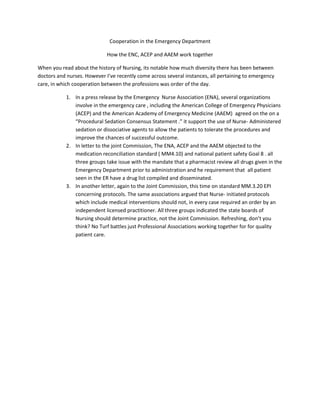Ellen
- 1. Cooperation in the Emergency Department <br />How the ENC, ACEP and AAEM work together<br />When you read about the history of Nursing, its notable how much diversity there has been between doctors and nurses. However I’ve recently come across several instances, all pertaining to emergency care, in which cooperation between the professions was order of the day.<br />In a press release by the Emergency Nurse Association (ENA), several organizations involve in the emergency care , including the American College of Emergency Physicians (ACEP) and the American Academy of Emergency Medicine (AAEM) agreed on the on a “Procedural Sedation Consensus Statement .” it support the use of Nurse- Administered sedation or dissociative agents to allow the patients to tolerate the procedures and improve the chances of successful outcome.
- 2. In letter to the joint Commission, The ENA, ACEP and the AAEM objected to the medication reconciliation standard ( MM4.10) and national patient safety Goal 8 . all three groups take issue with the mandate that a pharmacist review all drugs given in the Emergency Department prior to administration and he requirement that all patient seen in the ER have a drug list compiled and disseminated.
- 3. In another letter, again to the Joint Commission, this time on standard MM.3.20 EPI concerning protocols. The same associations argued that Nurse- initiated protocols which include medical interventions should not, in every case required an order by an independent licensed practitioner. All three groups indicated the state boards of Nursing should determine practice, not the Joint Commission. Refreshing, don’t you think? No Turf battles just Professional Associations working together for for quality patient care. <br />Emergency Nursing -is a specialty in which nurses care for patients in the emergency or critical phase of their illness or injury and are adept at discerning life-threatening problems, prioritizing the urgency of care, rapidly and effectively carrying out resuscitative measures and other treatment, acting with a high degree of autonomy and ability to initiate needed measures without outside direction, educating the patient and his family with the information and emotional support needed to preserve themselves as they cope with a new reality. These activities may be carried out in a variety of settings and not necessarily in an "Emergency Room." The Emergency Nurse typically works with patients who are not yet diagnosed, may have new problems not previously perceived, is not yet accustomed to the institutional environment, is still struggling to deal with a new reality of illness or injury, who may have an element of uncertainty to their problem, and who may have intoxicants or other behavioral barriers to effective diagnosis or treatment. The Emergency Nurse is at "the front line" of the hospital's contact with the community. The environment and patient situations are dynamic. There is some risk of personal harm from situations that are not yet completely controlled. The Emergency Nurse may need to assess and provide guidance for patients who call for "advice" or who have not yet arrived in the Emergency Department. The Emergency Nurse must also be sensitive and skilled in discerning the patient's educational needs to understand and care for the problem and be a successful and supportive teacher under less-than-ideal conditions. Likewise, the Emergency Nurse must be similarly talented with psychosocial problems and be knowledgeable of available community resources and able to implement them. Emergency Nursing has drawn nurses from many backgrounds and specialties, and the rich eclecticism this brings gives vitality and useful support for colleagues. Often, there has been a strong medical-surgical, critical-care, or cardiac background, however, with good support new graduates have succeeded in Emergency Nursing. The focus is on broad clinical knowledge, excellent skills, flexible and adaptable approach, and strong inter-personal and teaching ability. Certification courses in adult and child advanced life support, and core-curricula in Emergency Nursing and in Trauma are useful. A good Emergency Nurse continues education and training throughout the career. Advanced degrees are available for those who wish to pursue a career as a Clinical Nurse Specialist or Nurse Practitioner, or who intend to teach or conduct research.Emergency Nursing comprises all aspects of initial critical care whether applied to trauma-originating problems or those of medical or surgical origin or in the treatment of other specialties such as mental health. In those settings, where there is high focus or numbers of trauma patients, that designation has often been found but reflects a sub-specialty narrowing of view or clientele. "Trauma Nurse" has also been used to describe the days or weeks of intensive-care nursing of trauma patients in hospital; yet while these are part of the spectrum of care from injury to recovery, ---it is an "Emergency Nurse" who provides the initial care, resuscitation, and management so that the patient, whether ill or injured, is able to survive to the next phase of his "spectrum of care."


